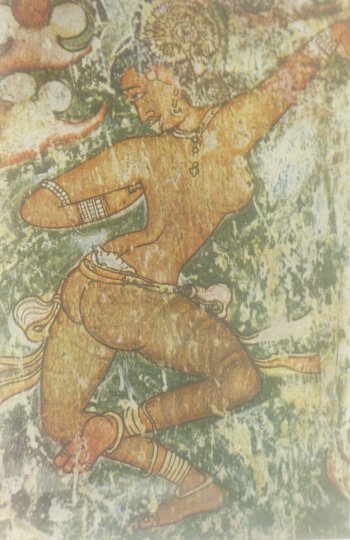The Frescoes of Ajanta
By Dr. Jyotsna Kamat
First Online: February 09, 2008
Page Last Updated: December 07, 2024
Discovery of world famous Ajanta caves was accidental. During the winter of 1819 captain Morgan of Madras regiment had gone hunting with a team in the thick forest of eastern range of Sahyadri mountains (now in Maharashtra). He lost his way and spotted a number of caves behind thick shrubs. Local shepherds in the distance informed him that the caves were carved and not natural and presently ghosts danced as the night fell! The dashy captain made his way to caves cutting thick shrubs. He landed verily on the treasure trove of Indian Art, which had a history of 1200 years! Nature, in the form of forest had guarded it from vandals, marauders and iconoclasts for that long period.
The 29 carved caves of Ajanta have glorious past of more than eight centuries ( from 200 BC to to 700 CE). The sculptures and the paintings in these caves was undertaken when Buddhism was at its peak in India. Buddhist monks totally devoted to Buddha's advice of meditating, teaching and preaching also tried to spread his message through various arts. It was essential for a true disciple to practice and perfect one art or the other (sippa- shilpa). The rock-cut chaityas and viharas of Ajanta, represent teachings of both Hinayana and Mahayana schools of Buddhism. The reigning monarchs and rich merchants financed the art, spread over centuries. Majority of the themes represent life of Buddha and his avatara (incarnations) depicted in Jataka tales. There is depiction of plant and flowers as also scenes from every day life in the frescos.
K.L. Kamat/Kamat's Potpourri
Buddhist Painting, Ajanta Caves
Plastering rock cut walls, was a finely developed art in ancient India. Mixture of mud, sand, fibre and gluey material was applied. Two more layers of processed paste of similar finer material followed. After drying of the plaster, pictures were drawn with very fine brushes made of hair in a squirrel's tail and down in the ear of calves. Colours were obtained from rocks, plants and flowers, which contained permanent hues.
K.L. Kamat/Kamat's Potpourri
Ardhanarishwara, Ajanta
One Captian Gill worked from 1845 to 1857 to copy out ther pictures and sent them to England. He had unwilling workers, huge bats, (whose flutterings all the time was mistaken for "ghost dancing" by the shepherds) and seepage. The wandering fakirs and beggars had damaged the caves further by cooking and accruing smoke. The paintings sent by Gill were lent to an Art exhibition in 1866 when a huge fire broke out and destroyed them. But some tracings were left which were reproduced as wood cuts. Finally some select paintings in book form, "The Buddhist Caves of Ajanta" by Griffiths of J.J School of Art Bombay came out in 1896, which was highly praised by art lovers through out the world.
Lord Curzon the Viceroy of India (1900 -1906 ?) is known as an imperialist and architect of Partition of Bengal in 1905, which led to nation-wide agitation. But he was a great lover of art as well. We owe today most of our art heritage to the law he passed for preservation of ancient monuments. His visit to Ajanta caves early in 1900, paved way for conservation. The damage wrought by bats, water seepage and scribbling of sightseers was stopped as also pilferage of pieces painting carried away as mementoes.
See Also:
- Great Art Centers of India
- The Treasures of of Sanchi

